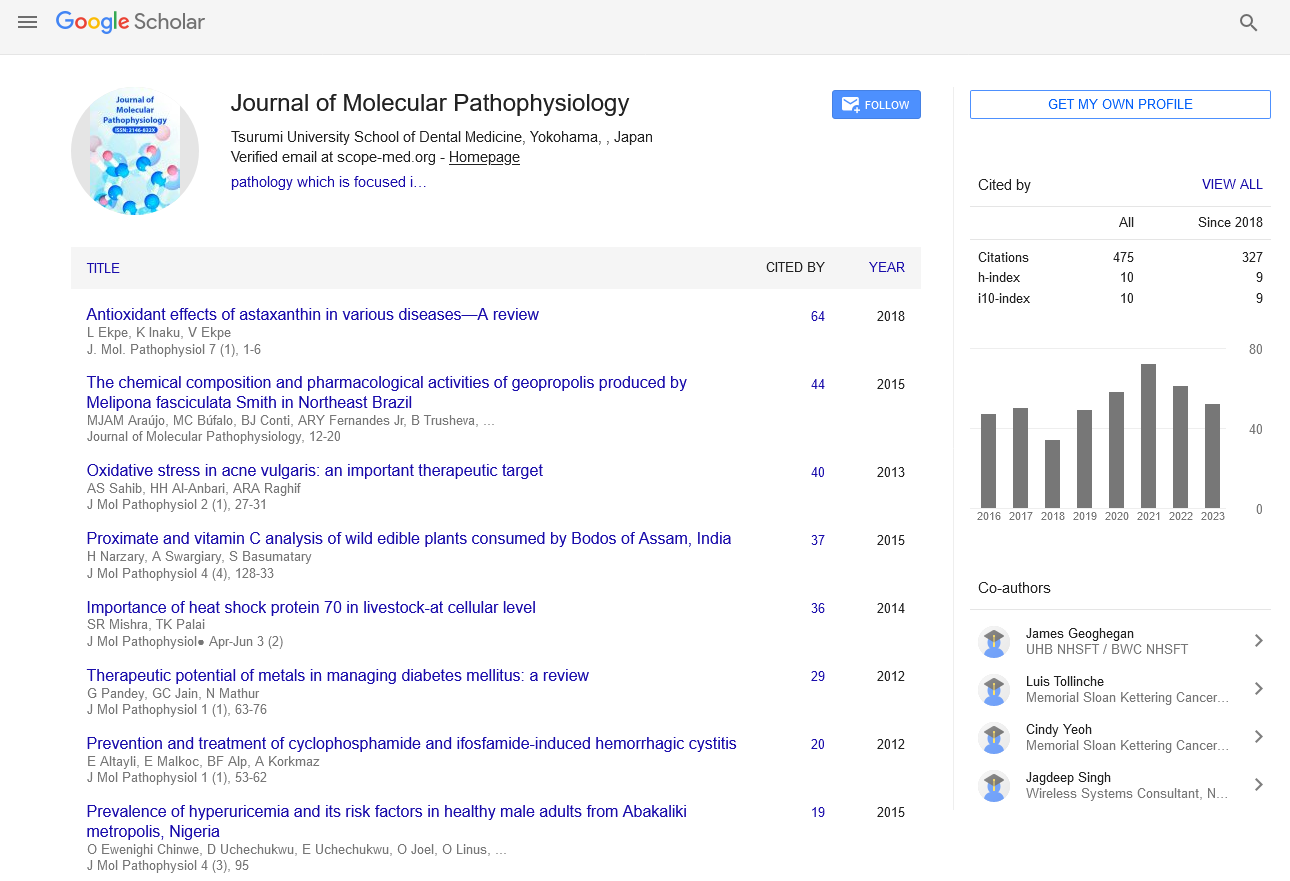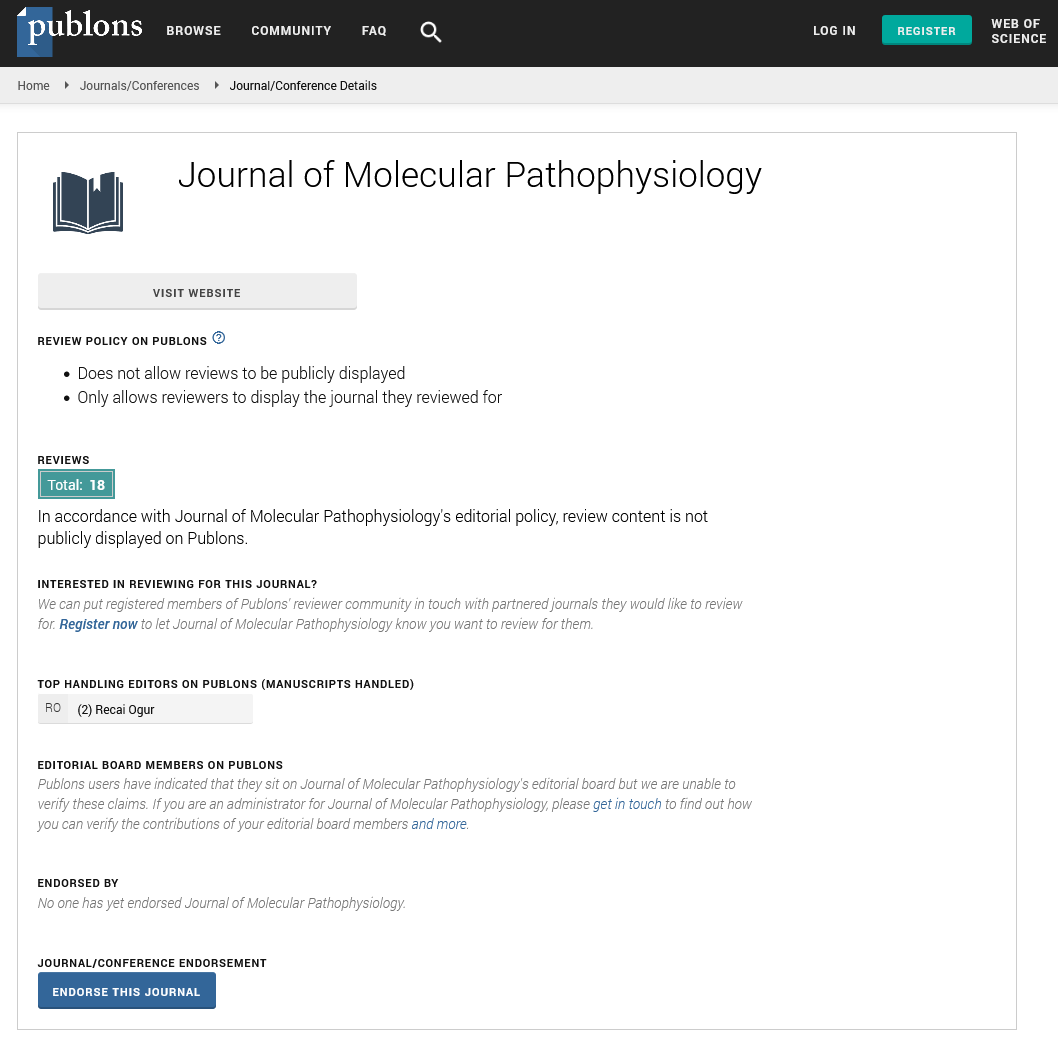Opinion Article - Journal of Molecular Pathophysiology (2024)
Neuroinflammatory Cascades and Excitotoxicity in Amyotrophic Lateral Sclerosis
Emile Orwell*Emile Orwell, Department of Neurology, Sorbonne University, Paris, France, Email: Emileorw999@yahoo.com
Received: 23-Feb-2024, Manuscript No. JMOLPAT-24-130697; Editor assigned: 26-Feb-2024, Pre QC No. JMOLPAT-24-130697 (PQ); Reviewed: 12-Mar-2024, QC No. JMOLPAT-24-130697; Revised: 19-Mar-2024, Manuscript No. JMOLPAT-24-130697 (R); Published: 26-Mar-2024
About the Study
Amyotrophic Lateral Sclerosis (ALS), also known as Lou Gehrig's disease, stands as a formidable adversary within the realm of neurodegenerative disorders. The condition is characterized by the gradual loss of motor neurons, which causes severe muscle atrophy, paralysis, and eventually death. Multiple pathways, including oxidative, inflammatory, mitochondrial, excitotoxic, and genetic interactions, play an important part in the pathophysiology of Acute Lung Syndrome (ALS).
The susceptibility of upper and lower motor neurons selectively is at the heart of ALS. Muscle atrophy and weakness are caused by the progressive degradation of these specialized cells, which are in control of sending signals from the brain to the muscles. The specific processes underlying motor neurons' vulnerability to degeneration are still not fully known. However, a number of variables, including as excitotoxicity, oxidative stress, mitochondrial malfunction, genetic alterations, and neuroinflammation, all plays a role in this sensitivity.
Genetic factors play a substantial role in both familial and sporadic forms of ALS. Mutations in various genes have been implicated, with the most notable being mutations in the C9orf72, SOD1, TARDBP, and FUS genes. These mutations disrupt cellular functions, leading to protein aggregation, impaired RNA metabolism, and dysregulated axonal transport. The accumulation of misfolded proteins and the formation of toxic aggregates contribute to neuronal dysfunction and eventual cell death.
Excitotoxicity, primarily mediated by excessive glutamate signaling, represents another critical aspect of ALS pathogenesis. Glutamate, the primary excitatory neurotransmitter in the central nervous system, plays a crucial role in neuronal communication. However, dysregulation of glutamate homeostasis leads to excitotoxicity, resulting in the over activation of glutamate receptors and subsequent calcium influx. This aberrant calcium signaling triggers a cascade of events, including mitochondrial dysfunction, oxidative stress, and ultimately, neuronal death. Mitochondria, the powerhouse of the cell, is essential for energy production, calcium homeostasis, and apoptosis regulation. In ALS, mitochondrial dysfunction is a prominent feature, characterized by impaired oxidative phosphorylation, increased Reactive Oxygen Species (ROS) production, and compromised mitochondrial dynamics. Dysfunctional mitochondria not only fail to meet the energy demands of neurons but also contribute to oxidative stress, protein misfolding, and apoptotic signalling, exacerbating neuronal damage.
Oxidative stress, resulting from an imbalance between the production of ROS and antioxidant defense mechanisms, is a pervasive feature of ALS pathology. Reactive oxygen and nitrogen species, generated during normal cellular metabolism, can damage lipids, proteins, and DNA, leading to cellular dysfunction and death. Neuronal injury and degeneration are made possible in ALS by a hostile environment that is exacerbated by impaired antioxidant defenses, increased production of ROS from mitochondria, and activated glial cells.
Progressive neuroinflammation can worsen neuronal damage and increase the development of a disease, even while it first acts as a defensive reaction to harm. In order to prolong neuronal dysfunction and accelerate neuroinflammatory cascades, activated microglia produce pro-inflammatory cytokines, chemokines, and neurotoxic substances. Moreover, reactive gliosis occurs in astrocytes, which reduces their ability to sustain and promotes the degeneration of motor neurons. In addition to neuronal cell bodies, ALS disease includes synaptic dysfunction and axonal degeneration, which disturb the complex web of neural connections necessary for motor function. Axonal transport defects, resulting from cytoskeletal abnormalities and impaired molecular motors, compromise the delivery of essential cargoes to distal axons and synapses. This leads to synaptic dysfunction, which exacerbates muscular weakness and atrophy by reducing neurotransmitter release and synaptic plasticity.
Copyright: © 2024 The Authors. This is an open access article under the terms of the Creative Commons Attribution Non Commercial Share Alike 4.0 (https://creativecommons.org/licenses/by-nc-sa/4.0/). This is an open access article distributed under the terms of the Creative Commons Attribution License, which permits unrestricted use, distribution, and reproduction in any medium, provided the original work is properly cited.







